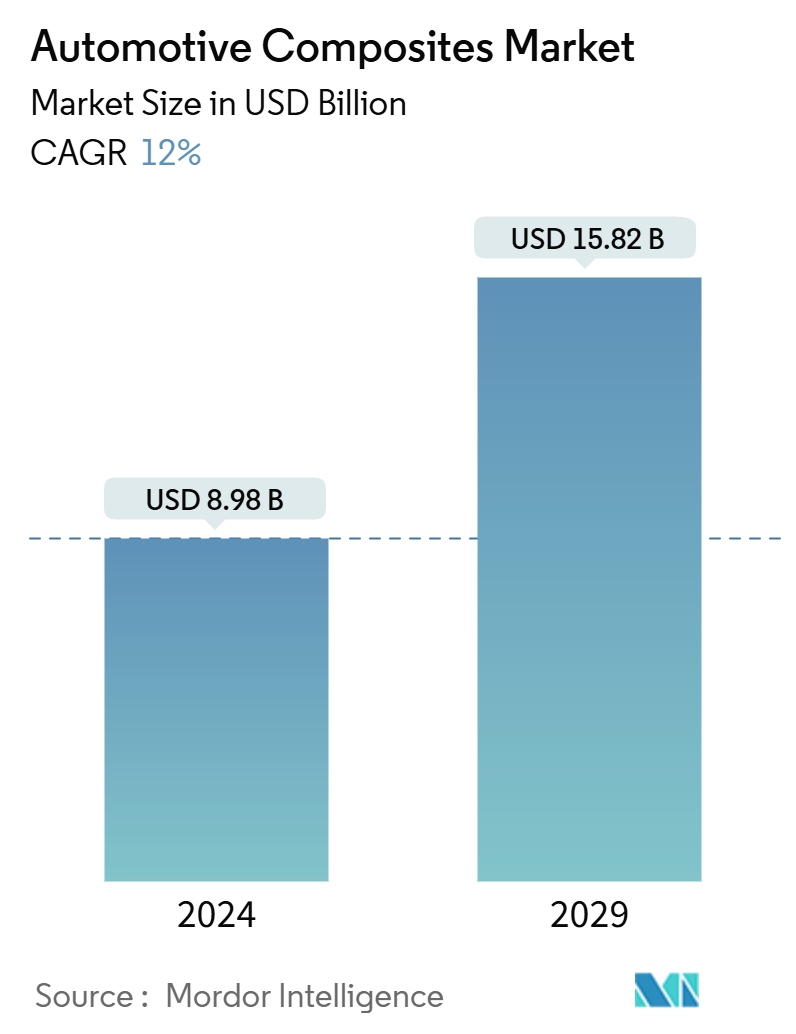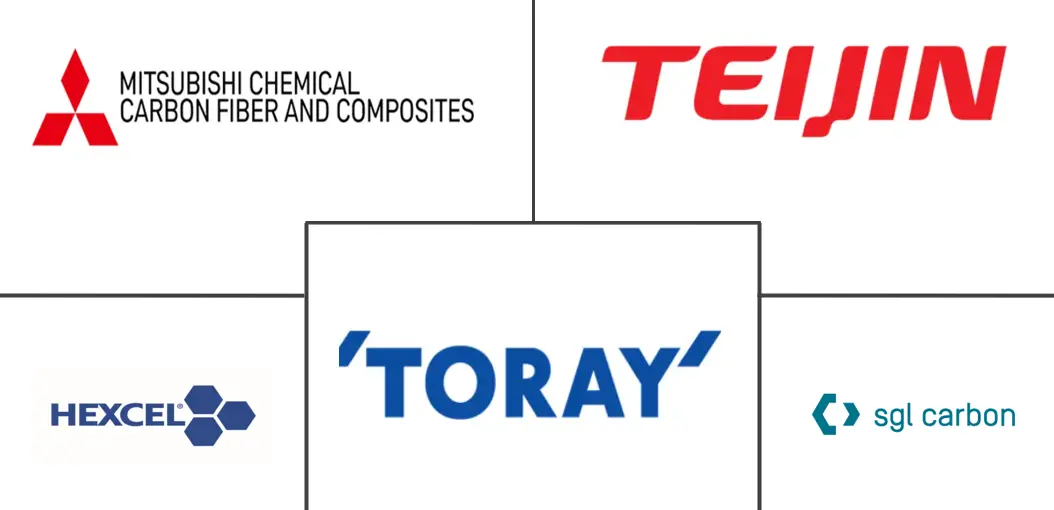Market Size of Automotive Composites Industry

| Study Period | 2019 - 2029 |
| Market Size (2024) | USD 8.98 Billion |
| Market Size (2029) | USD 15.82 Billion |
| CAGR (2024 - 2029) | 12.00 % |
| Fastest Growing Market | Asia Pacific |
| Largest Market | Asia Pacific |
| Market Concentration | Medium |
Major Players
*Disclaimer: Major Players sorted in no particular order |
Automotive Composites Market Analysis
The Automotive Composites Market size is estimated at USD 8.98 billion in 2024, and is expected to reach USD 15.82 billion by 2029, at a CAGR of 12% during the forecast period (2024-2029).
Over the medium term, the automotive industry's rising demand for lightweight materials and increasing focus on fuel efficiency is poised to significantly propel market growth. Yet, the steep costs of carbon fiber and glass fiber composites pose a challenge to this expansion. Integrating these composites into budget-friendly vehicles could lead to a notable price uptick.
Moreover, the limited recyclability of composite materials stands as a significant hurdle for their use in entry-level passenger vehicles. This challenge is intensified by the intricate nature of composite structures, which often comprise diverse components that are hard to separate and process. Still, a notable trend is emerging: original equipment manufacturers (OEMs) are increasingly collaborating with suppliers, driven by several pivotal factors.
As the automotive sector confronts the pressing need to craft fuel-efficient vehicles in line with stringent environmental mandates, the appetite for lightweight materials has surged. This demand is especially pronounced in the swiftly growing lightweight electric vehicle segment, where weight reduction is vital for boosting battery efficiency and overall performance.
Moreover, industry giants like BMW and Nissan are delving into pioneering methods to substitute conventional metal parts with cutting-edge composite fibers. This transition not only meets the demand for lighter vehicle frameworks but also aligns with sustainability objectives by potentially curtailing the carbon footprint of vehicle manufacturing.
Automotive Composites Industry Segmentation
Composites are playing a pivotal role in the evolution of vehicles, making them lighter, safer, and more fuel-efficient. A composite material is formed by embedding high-performance fibers, like carbon or glass, into a matrix, usually an epoxy polymer. This combination yields properties that surpass those of the individual components.
The automotive composites market is segmented by application type, material type, and geography. By application type, the market is segmented as Structural Assembly, Powertrain Component, Interior, and Exterior. By Material Type, the market is segmented as Thermoset Polymer, Thermoplastic Polymer, Carbon Fiber, And Glass Fiber. By Geography, the market is segmented as North America, Europe, Asia-Pacific, and the Rest of the World. For each segment, the market sizing and forecast have been done based on the value (USD).
| By Application Type | |
| Structural Assembly | |
| Powertrain Component | |
| Interior | |
| Exterior | |
| Others |
| By Material Type | |
| Thermoset Polymer | |
| Thermoplastic Polymer | |
| Carbon Fiber | |
| Glass Fiber |
| By Geography | |||||||
| |||||||
| |||||||
| |||||||
|
Automotive Composites Market Size Summary
The automotive composites market is poised for significant growth, driven by the increasing demand for lightweight materials in the automotive industry. This demand is largely fueled by the need for improved fuel efficiency and adherence to stringent emission regulations globally. Despite the initial setbacks caused by the COVID-19 pandemic, which disrupted production and reduced vehicle sales, the market is expected to recover and expand. The focus on reducing vehicle weight to enhance driving dynamics and fuel economy is a key factor propelling the adoption of composites. However, the high costs associated with carbon and glass fiber composites, along with their low recyclability, pose challenges to their widespread use, particularly in entry-level vehicles. Collaborations between original equipment manufacturers (OEMs) and suppliers are expected to create opportunities for integrating composites into more vehicles, as major automotive players seek to replace metal parts with lighter composite materials.
The market landscape is characterized by a strong presence in the Asia-Pacific region, followed by Europe and North America, with India emerging as a significant player due to its expanding automotive industry and rising consumer awareness about fuel efficiency. The demand for customized and high-performance vehicles, such as sports and racing cars, is also contributing to the market's growth, as these vehicles have long utilized thermoset composites. Key industry players, including Mitsubishi Chemical, Toray Industries, and SGL Carbon, are actively developing innovative composite materials to meet the evolving needs of the automotive sector. These advancements are expected to drive the market towards exponential growth, as manufacturers strive to meet higher fuel economy standards and reduce vehicle emissions.
Automotive Composites Market Size - Table of Contents
-
1. MARKET DYNAMICS
-
1.1 Market Driver
-
1.1.1 Increase in Demand for Lightweight Vehicles Witnessing Major Market Growth
-
-
1.2 Market Restraint
-
1.2.1 High Processing and Manufacturing Cost of Composite Material
-
-
1.3 Industry Attractiveness - Porter's Five Forces Analysis
-
1.3.1 Threat of New Entrants
-
1.3.2 Bargaining Power of Buyers/Consumers
-
1.3.3 Bargaining Power of Suppliers
-
1.3.4 Threat of Substitute Products
-
1.3.5 Intensity of Competitive Rivalry
-
-
-
2. MARKET SEGMENTATION (Market Size in Value (USD)
-
2.1 By Application Type
-
2.1.1 Structural Assembly
-
2.1.2 Powertrain Component
-
2.1.3 Interior
-
2.1.4 Exterior
-
2.1.5 Others
-
-
2.2 By Material Type
-
2.2.1 Thermoset Polymer
-
2.2.2 Thermoplastic Polymer
-
2.2.3 Carbon Fiber
-
2.2.4 Glass Fiber
-
-
2.3 By Geography
-
2.3.1 North America
-
2.3.1.1 United States
-
2.3.1.2 Canada
-
2.3.1.3 Rest of North America
-
-
2.3.2 Europe
-
2.3.2.1 Germany
-
2.3.2.2 United Kingdom
-
2.3.2.3 France
-
2.3.2.4 Italy
-
2.3.2.5 Rest of Europe
-
-
2.3.3 Asia-Pacific
-
2.3.3.1 China
-
2.3.3.2 Japan
-
2.3.3.3 India
-
2.3.3.4 South Korea
-
2.3.3.5 Rest of Asia-Pacific
-
-
2.3.4 Rest of the World
-
2.3.4.1 South America
-
2.3.4.2 Middle-East and Africa
-
-
-
Automotive Composites Market Size FAQs
How big is the Automotive Composites Market?
The Automotive Composites Market size is expected to reach USD 8.98 billion in 2024 and grow at a CAGR of 12% to reach USD 15.82 billion by 2029.
What is the current Automotive Composites Market size?
In 2024, the Automotive Composites Market size is expected to reach USD 8.98 billion.

